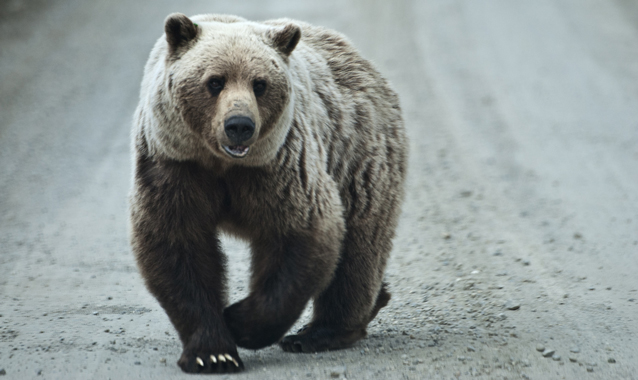
A grizzly bear on the roadway at Glacier National Park
Note: This post refers to events in Montana during a recent trip there.
I could sense there were people right behind us. Trying to be ever the courteous hiker, I stopped along side the trail on a rock, and turned around.
“Would you like to go ahead?”
The couple looked at us, muttering, “No, no, you go ahead. We heard there is a bear near the trail up ahead.”
Normally, this comment would not bother me. As a Park Ranger with the National Park Service, I’ve seen hundreds of bears over my many years working in wilderness parks around the west.
Of course, those bears were black bears, or Ursus Americanus. The name is really a bit of a misnomer, as black ears in the west can come in all different colors, including blonde, cinnamon, light brown, dark brown, and yes, black.
I’d never had any trouble with black bears in all my years of hiking. What I learned from working in the national parks is if are vigilant in storing your food correctly, whether day hiking, backpacking or camping, the black bears don’t bother you.
But this day, we are hiking in grizzly country. An encounter with a grizzly bear is an altogether different concept. One that struck fear in my heart. For one, a grizzly is much, much larger, averaging 400-600 pounds and even more. They are powerful creature with an ability to attack and tear things apart.
And unlike Black Bears, there have been several incidents of grizzlies attacking people that had nothing to do with human food.
As we continued along, now a group of four of us, we spotted another couple ahead. They had stopped and seemed to be waiting for us. As we approached, they fell in line with us — we are now a train of six people. Everyone seemed to feel better about this fact, sensing that we had safety in numbers.
Another precaution we had taken is bringing a bottle of bear spray with us. Fortunately for us, our bed and breakfast had ample bottles and allowed us to check out a bottle while hiking in Glacier National Park.
With black bears, as a Park Ranger, I didn’t normally advocate for people to carry bear spray, only because it can cause more problems instead of helping people. The main thing is that it a) encourages people to get closer to a bear than they should and b) in the excitement of trying to use it, people often spray themselves instead of the bear. The goal is to do everything possible not to get close to a bear, and with black bears I have found that throwing rocks, waving arms, yelling as loud as possible usually drives the bear off.
But with grizzlies, I am in unfamiliar territory. They act differently. Despite their size, they can lumber across the tundra quite quickly, and I am worried about being surprised by a bear. The Park Service advises to play dead with a grizzly, lying on your stomach. The literature says don’t let the bear roll you over. Easy to say, but I imagine much harder to do when you are a 130-pound woman and the bear is 600 pounds. This helpful piece of literature claims the bear will lose interest and leave once you have convinced him you are “dead.”
So off we went with our train of hikers and armed with our bear spray to Grinnell Glacier. Part of me didn’t want to worry about an encounter, but the other part of me secretly hoped to see one of these amazing creatures. After all, living in Colorado, I’d pretty much seen everything else, but the last grizzly died in Colorado in the early 1900s. To see one, would be one of the most exciting moments I’d ever had in a national park.
All my consternation proved to be for naught, as we didn’t see any grizzly bears. It may have been because the three trails we hiked were heavily trafficked by hikers, hundreds of hikers. And as the literature said, they don’t tend to approach groups of people.
Totally unused, we returned our bear spray. Perhaps when we finally make our trip to Alaska. Until then…

